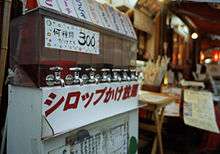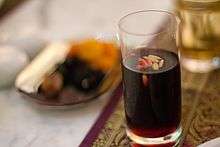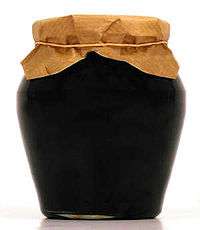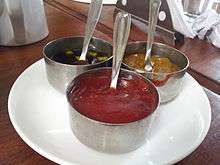Grape syrup
Grape syrup is a condiment made with concentrated grape juice. It is thick and sweet because of its high ratio of sugar to water. Grape syrup is made by boiling grapes, removing their skins, squeezing them through a sieve to extract the juice, and adding sugar. Like other fruit syrups, a common use of grape syrup is as a topping to sweet cakes, such as pancakes or waffles.


.jpg)
Names and etymology
The ancient Greek name for grape syrup is ἕψημα (epsima), which translates to 'boiled'.[1] The Greek name was used in Crete and, in modern times, in Cyprus.[2]
Petimezi is the name for a type of Mediterranean grape syrup. The word comes from the Turkish pekmez, which usually refers to grape syrup, but is also used to refer to mulberry and other fruit syrups.[3][4]
Vincotto (not to be confused with vino cotto) is the southern Italian term for grape syrup. It is made only from cooked wine grape must (mosto cotto), with no fermentation involved. There is no alcohol or vinegar content, and no additives, preservatives or sweeteners are added. It is both a condiment and ingredient used in either sweet or savory dishes.
History
Greco-Roman
One of the earliest mentions of grape syrup comes from the fifth-century BC Greek physician Hippocrates, who refers to hépsēma (ἕψημα), the Greek name for the condiment.[5] The fifth-century BC Athenian playwright Aristophanes also makes a reference to it, as does Roman-era Greek physician Galen.[5]
Grape syrup was known by different names in Ancient Roman cuisine depending on the boiling procedure. Defrutum, carenum, and sapa were reductions of must. They were made by boiling down grape juice or must in large kettles until it had been reduced to two-thirds of the original volume, carenum; half the original volume, defrutum; or one-third, sapa. Roman general Pliny the Elder states that grape syrup was also referred to as siraion (Greek: "σίραιον").[6][7]
The main culinary use of defrutum was to help preserve and sweeten wine, but it was also added to fruit and meat dishes as a sweetening and souring agent and even given to food animals such as ducks and suckling pigs to improve the taste of their flesh. Defrutum was mixed with garum to make the popular condiment oenogarum. Quince and melon were preserved in defrutum and honey through the winter, and some Roman women used defrutum or sapa as a cosmetic. Defrutum was often used as a food preservative in provisions for Roman troops.[8]
There is some confusion as the amount of reduction for sapa and defrutum. As James Grout explains in its Encyclopedia Romana,[9] authors informed different reductions, as follows: "The elder Cato, Columella, and Pliny all describe how unfermented grape juice (mustum, must) was boiled to concentrate its natural sugars. "A product of art, not of nature," the must was reduced to one half (defrutum) or even one third its volume (sapa) (Pliny, XIV.80),[10] although the terms are not always consistent. Columella identifies defrutum as "must of the sweetest possible flavour" that has been boiled down to a third of its volume (XXI.1).[11] Isidore of Seville, writing in the seventh century AD, says that it is sapa that has been reduced by a third but goes on to imagine that defrutum is so called because it has been cheated or defrauded (defrudare) (Etymologies, XX.3.15).[12] Varro reverses Pliny's proportions altogether (quoted in Nonius Marcellus, De Conpendiosa Doctrina, XVIII.551M).[13]" Defrutum is mentioned in almost all Roman books dealing with cooking or household management. Pliny the Elder recommended that defrutum only be boiled at the time of the new moon, while Cato the Censor suggested that only the sweetest possible defrutum should be used.
In ancient Rome, grape syrup was often boiled in lead pots, which sweetened the syrup through the leeching of the sweet-tasting chemical compound lead acetate into the syrup. Incidentally, this is thought to have caused lead poisoning for Romans consuming the syrup.[14][15] A 2009 History Channel documentary produced a batch of historically accurate defrutum in lead-lined vessels and tested the liquid, finding a lead level of 29,000 parts per billion (ppb), which is 2,900 times higher than contemporary American drinking water limit of 10 ppb. These levels are easily high enough to cause either acute lead toxicity if consumed in large amounts or chronic lead poisoning when consumed in smaller quantities over a longer period of time (as defrutum was typically used).[15]
However, the use of leaden cookware, though popular, was not the general standard of use. Copper cookware was used far more generally and no indication exists as to how often sapa was added or in what quantity. There is not, however, scholarly agreement on the circumstances and quantity of lead in these ancient Roman condiments. For instance, the original research was done by Jerome Nriagu, but was criticized by John Scarborough, a pharmacologist and classicist, who characterized Nriagu's research as "so full of false evidence, miscitations, typographical errors, and a blatant flippancy regarding primary sources that the reader cannot trust the basic arguments."[16]
Modern
Cyprus
The ancient Greek name hépsēma (now pronounced épsēma in Cypriot Greek) is still used to refer to the condiment, which is still made in Cyprus.
Greece
| Nutritional value per 100 g (3.5 oz) | |
|---|---|
| Energy | 1,380 kJ (330 kcal) |
80.9 g | |
0.4 g | |
0.9 g | |
| Minerals | Quantity %DV† |
| Calcium | 7% 74 mg |
| Iron | 9% 1.2 mg |
| Phosphorus | 6% 40 mg |
Varkazas, p. 203 | |
| |
| †Percentages are roughly approximated using US recommendations for adults. | |
Petimezi (Greek: πετιμέζι Greek pronunciation: [petiˈmezi]), also called epsima (έψημα) and in English "grapemust" or "grape molasses", is a syrup that is reduced until it becomes dark and syrupy. Petimezi keeps indefinitely. Its flavor is sweet with slightly bitter undertones. The syrup may be light or dark colored, depending on the grapes used. Before the wide availability of inexpensive cane sugar, petimezi was a common sweetener in Greek cooking, along with carob syrup and honey. Petimzei is still used today in desserts and as a sweet topping for some foods. Though petimezi can be homemade,[17][18] it is also sold commercially under different brand names.
Fruits and vegetables that have been candied by boiling in petimezi (epsima) are called retselia.
From late August until the beginning of December, many Greek bakeries sell dark crunchy and fragrant petimezi cookies, moustokoúloura (Greek: μουστοκούλουρα), are made.
Petimezopita (Greek: πετιμεζόπιτα) is a spiced cake with petimezi.[19]
Iran
In Iranian cuisine, grape syrup (in Persian: شیره انگور) is used to sweeten ardeh (tahini), which is consumed at breakfast. An alternative is date syrup, which is also widely used in Middle Eastern cooking.
Italy
Saba, (from the Latin word sapa, with the same meaning), vincotto or vino cotto is commonly used in Italy, especially in the regions of Emilia Romagna, Marche, Calabria, and Sardinia, where it is considered a traditional flavor.
Spain

Arrope is a form of grape concentrate typically produced in Spain. Often derived from grape varieties such as Pedro Ximénez, it is made by boiling unfermented grape juice until the volume is reduced by at least 50%, and its viscosity reduced to a syrup.[20][21] The final product is a thick liquid with cooked caramel flavours, and its use is frequent as an additive for dark, sweet wines such as sweet styles of sherry, Malaga, and Marsala.[21]
See also
- Churchkhela, a sausage-shaped candy made from grape must and nuts
- Drakshasava, an Ayurvedic tonic made from grapes
- List of grape dishes
- List of syrups
- Moustalevria
- Must
- Pekmez, a similar product in the Ottoman world
- Vino cotto
- List of fruit dishes
References
- The Online Liddell-Scott-Jones Greek-English Lexicon s.v.
- "Έψημα". foodmuseum.cs.ucy.ac.cy (in Greek). Cyprus Food Virtual Museum. Retrieved 20 November 2015.
- Dictionary of the Türk Dil Kurumu
- A.D. Alderson and Fahir İz, The Concise Oxford Turkish Dictionary
- Jacques Jouanna Greek Medicine from Hippocrates to Galen: Selected Papers, 2012, p. 190. ISBN 978 90 04 20859 9
- The Online Liddell-Scott-Jones Greek-English Lexicon s.v.
- Pliny the Elder, The Natural History 14:11
- Director: Chris Warren (2004). Tales of the Living Dead: Poisoned Roman Babies (television). Brighton TV for National Geographic.
- Grout, James. "Lead Poisoning and Rome". Encyclopedia Romana. James Grout. Retrieved 19 August 2019.
- The Elder, Pliny (1945). Natural History, Volume I: Books 1-2. Translated by H. Rackham (Loeb Classical Library ed.). Cambridge, MA: Harvard University Press.
- Columella, Lucius Junius Moderatus (1954). On Agriculture. translated by E. S. Forster and Edward H. Heffner (Loeb Classical Library ed.). Cambridge, MA: Harvard University Press. ISBN 9780674993983.
- Isidore of Seville's, Saint (2005). Isidore of Seville's Etymologies. The Complete Translations of Isidori Hipalensis Episcopi Etimologiarum Sive Originum Libre XX. Translated from Latin by Priscilla Throop (Priscilla Throop ed.). Charlotte, Vermont: Priscilla Throop. p. XX 3 14–15. ISBN 978-1-4116-6526-2. Retrieved 19 August 2019.
- Marcellus, Nonius (1903). De Conpendiosa Doctrina (Vol. III)edited by Wallace M. Lindsay.
- Bernstein, Lenny (2016-02-17). "Lead poisoning and the fall of Rome". Washington Post. ISSN 0190-8286. Retrieved 2018-02-05.
- Nriagu, Jerome O. (17 March 1983). "Saturnine Gout among Roman Aristocrats. Did lead poisoning contribute to the fall of the Empire?". New England Journal of Medicine. 308 (11): 660–663. doi:10.1056/NEJM198303173081123. PMID 6338384.
- Scarborough, J (October 1984). "The myth of lead poisoning among the Romans: an essay review". Journal of the History of Medicine and Allied Sciences. 39 (4): 469–75. doi:10.1093/jhmas/39.4.469. PMID 6389691.
- Nancy Gaifyllia. "Naturally Sweet Grape Syrup - Petimezi - Greek Recipe for Grape Molasses". About.com Food. Retrieved 15 February 2016.
- "Petimezi - Greek Grape Syrup". Retrieved 15 February 2016.
- Nancy Gaifyllia. "Petimezopita Grape Molasses Spice Cake Recipe - Greek Desserts and Cake Recipes". About.com Food. Retrieved 15 February 2016.
- Robinson, Jancis, ed. (1999). "Arrope". The Oxford Companion to Wine (2nd ed.). winepros.com.au. Archived from the original on 2011-07-06.
- Robinson, Jancis, ed. (1999). "Grape concentrate". The Oxford Companion to Wine (2nd ed.). winepros.com.au. Archived from the original on 2011-04-04.
Further reading
- Theodoros Varzakas, Athanasios Labropoulos, Stylianos Anestis, eds., Sweeteners: Nutritional Aspects, Applications, and Production Technology, 2012, ISBN 143987672X, p. 201ff.
- Harris, Andy Modern Greek: 170 Contemporary Recipes from the Mediterranean. Chronicle Books, 2002. ISBN 0-8118-3480-8 ISBN 978-0-8118-3480-3
- Ilaria G. Giacosa; A Taste of Ancient Rome; University of Chicago Press; ISBN 0-226-29032-8 (paperback, 1994)
- Pliny the Elder; Natural History; tr. H. Rackham; Harvard University Press (Loeb Classical Library); ISBN 0-674-99432-9 (cloth, 1956)
- Marcus Porcius Cato; On Agriculture ; Harvard University Press (Loeb Classical Library); ISBN 0-674-99313-6 (hardcover, 1979)
External links
| Wikimedia Commons has media related to Grape syrup. |
